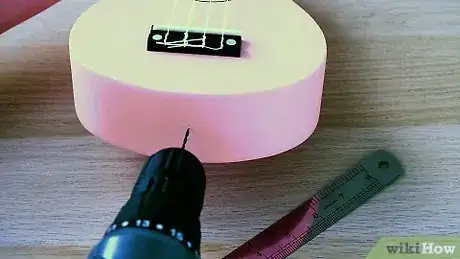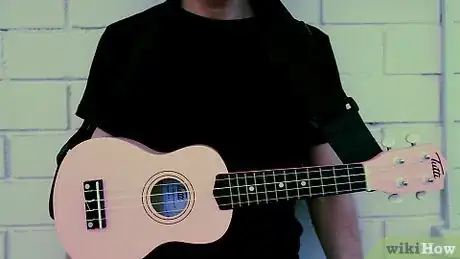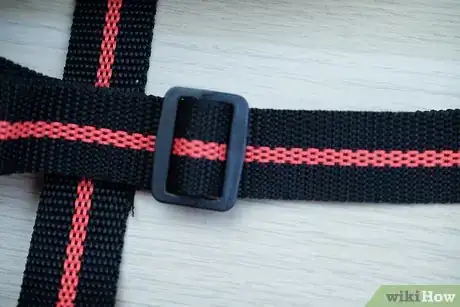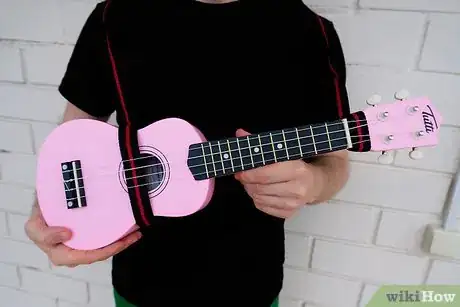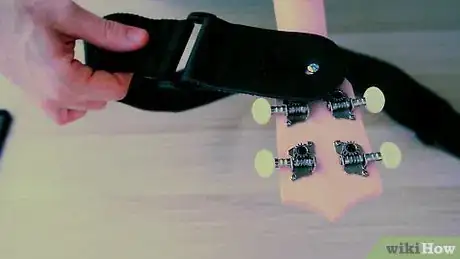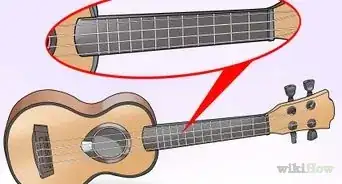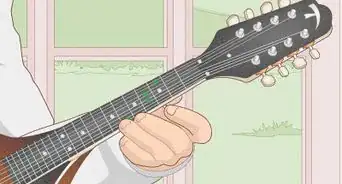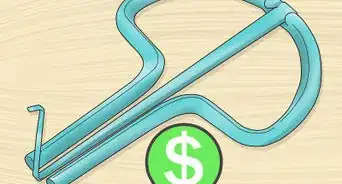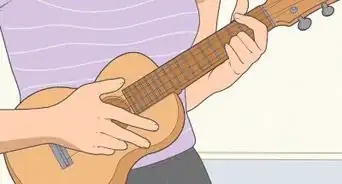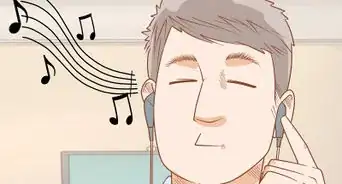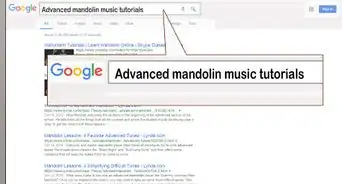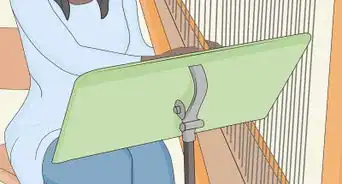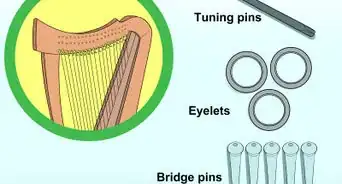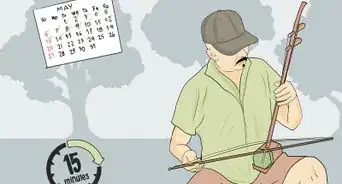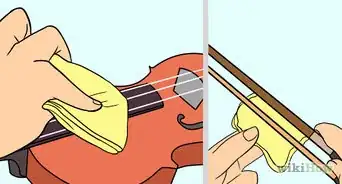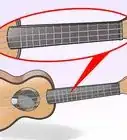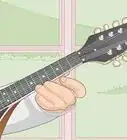This article was co-authored by wikiHow staff writer, Janice Tieperman. Janice is a professional and creative writer who has worked at wikiHow since 2019. With both a B.A. and M.A. in English from East Stroudsburg University, she has a passion for writing a wide variety of content for anyone and everyone. In her free time, you can find her working on a new crochet pattern, listening to true crime podcasts, or tackling a new creative writing project.
There are 11 references cited in this article, which can be found at the bottom of the page.
The wikiHow Video Team also followed the article's instructions and verified that they work.
This article has been viewed 14,593 times.
Learn more...
The ukulele is a bright, fun instrument that’s easy to carry around with you. While you can hold and play your ukulele at the same time, straps offer a lot of freedom in how you can play your instrument. It’s usually best to use a ukulele strap whenever you play, as guitar straps can be a bit too bulky.[1] Thankfully, it takes fewer than 10 minutes to install a strap on your instrument, so you can get back to making music!
Steps
Adding Buttons to Attach a Strap
-
1Measure the bottom of your ukulele to find the center point. Flip your ukulele over so the thick, bottom section of the instrument is facing up. Place a ruler or measuring tape vertically along the instrument, then find the center point along the base of your ukulele.[2]
- For instance, if the base of your ukulele is only 2 in (5.1 cm) wide, mark along the 1 in (2.5 cm) point.
- Some players prefer to only use 1 button along the bottom of their instrument.
-
2Mark the central point of the instrument with a small notch. Use a nail or other sharp item to mark the center. Ideally, try to center this mark between the second and third strings on your ukulele.[3]
- Double-check that your measurement is correct before marking your instrument.
Advertisement -
3Drill a 1⁄4 in (0.64 cm) into the marked spot with a 1⁄16 in (0.16 cm) drill bit. Attach a really thin drill bit to an electric drill so your button can fit properly.[4]
- It may help to wrap a piece of tape about 1⁄4 in (0.64 cm) down your drill bit so you don’t drill too far into your instrument.
-
4Screw a metal button into your ukulele with a Phillips-head screwdriver. Slide the ukulele button onto a 1⁄4 in (0.64 cm) screw, then slide a felt washer beneath the button. Arrange the button, screw, and washer on top of the hole, then use a Phillips-head screwdriver to tighten the button into the instrument.[5]
- You can also use a Phillips-head head drill bit on your electric drill if you want to speed up the process.[6]
- You can find button straps online or at most music supply stores. These packages will come with buttons, felt washers, and screws for installation.
-
5Mark a spot behind the 2 highest strings on the back of the ukulele neck. Flip your instrument over gently and place it on a sturdy, padded surface. Find a spot behind the 2 highest strings of your instrument along the back of the ukulele neck, focusing on the left side. Lightly mark your desired button spot with a nail so you can remember where to drill.[7]
- You don’t need to do any exact measurements for this, as long as the button goes on the base of the ukulele neck.
-
6Drill about 1⁄4 in (0.64 cm) into the marked spot. Take your electric drill and add another small hole to your instrument. Only drill about 1⁄4 in (0.64 cm) into your instrument, as you don’t want to drill all the way through.[8]
- Since you’re working along the back of the neck, you may want to drill at an angle.[9]
-
7Secure the second button with a Phillips-head screwdriver. Slide the button onto the screw, followed by the felt washer. Center the screw on top of the drilled hole, then tighten it into place with a Phillips-head screwdriver.[10]
-
8Connect the strap to the buttons so you can wear your ukulele. Search along both ends of your ukulele straps for circular openings. Secure both ends along the top and bottom buttons of your ukulele to hold it in place. Once the strap is secure, loop it behind your neck so you can play your instrument![11]
Using a Hug Strap
-
1Tie your hug strap near the tuning pegs of the ukulele. Look for the thin, black portion along the end of the hug strap, also known as a headstock strap. Remove any rubber washers from this strap, then tie it beneath the strings along the top of the ukulele neck.[12]
- Make sure that the strap is below the strings, and not above them.
-
2Loop the thicker section of the strap about the body of the ukulele. Unthread the bulk of the hug strap from any buckles so it’s completely straight, then wrap it around the center of the instrument. At this time, check and make sure that your hug strap isn’t covering the main opening of your ukulele.[13]
- If you have a thicker, pineapple-shaped ukulele, a hug strap might not be a viable option for you.
-
3Thread the strap into the square buckle to tighten it. After pulling it through the buckle, check that the strap is really taut and secure so your instrument doesn’t move around a lot while you play. Additionally, double-check that the strap isn’t completely covering the center opening on your instrument, or else your music may not be as clear and loud.[14]
-
4Connect your hug strap to one of your ukulele buttons. Loop the headstock strap next to the tuning pegs to attach it around the top of your ukulele. Find a small, looped parachute cord at the bottom of your hug strap and secure it around the bottom button on your instrument. As a finishing touch, place a rubber washer on top of the button to make your strap secure.[15]
-
5Attach the hug strap to 2 ukulele buttons if you have them. Remove the thin, upper strap and rubber washers from the rest hug strap and find the small, looped parachute cord attached to the end of the hug strap. Loop this cord over the metal button on the neck of your instrument, then cover the top of the button with a rubber washer. Search along the bottom of your headstock strap for another looped parachute cord, then attach this to the bottom of your instrument, along with another rubber washer.[16]
Things You’ll Need
Adding Buttons to Attach a Strap
- Measuring tape
- Sharp tool
- Electric drill
- 2 ukulele buttons
- 2 1⁄4 in (0.64 cm) screws
- 2 felt washers
- Ukulele strap
References
- ↑ https://www.ukulelemag.com/stories/ukulele-straps-do-or-dont
- ↑ https://www.ukulelemag.com/stories/how-to-install-a-ukulele-strap
- ↑ https://www.ukulelemag.com/stories/how-to-install-a-ukulele-strap
- ↑ https://m.youtube.com/watch?v=cANQMU9U_I4&t=3m50s
- ↑ https://m.youtube.com/watch?v=cANQMU9U_I4&t=4m30s
- ↑ https://www.ukulelemag.com/stories/how-to-install-a-ukulele-strap
- ↑ https://www.ukulelemag.com/stories/how-to-install-a-ukulele-strap
- ↑ https://m.youtube.com/watch?v=cANQMU9U_I4&t=2m27s
- ↑ https://www.ukulelemag.com/stories/how-to-install-a-ukulele-strap
- ↑ https://m.youtube.com/watch?v=cANQMU9U_I4&t=2m42s
- ↑ https://www.ukulelemag.com/stories/how-to-install-a-ukulele-strap
- ↑ https://m.youtube.com/watch?v=Y4HosNRtaY0&t=5m4s
- ↑ https://soundchime.com/tips/how-does-a-ukulele-strap-attach/
- ↑ https://m.youtube.com/watch?v=Y4HosNRtaY0&t=6m3s
- ↑ https://m.youtube.com/watch?v=Y4HosNRtaY0&t=2m46s
- ↑ https://m.youtube.com/watch?v=Y4HosNRtaY0&t=0m42s
- ↑ https://soundchime.com/tips/how-does-a-ukulele-strap-attach/
